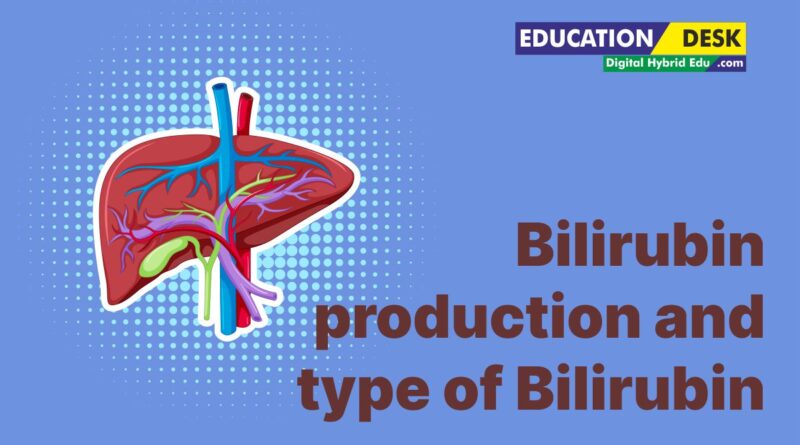Mechanism of Bilirubin production and type of Bilirubin
Mechanism of Bilirubin Production
Introduction
Bilirubin might sound like a term from a chemistry textbook, but it’s actually a crucial compound in your body. This tiny molecule plays significant roles, from helping to diagnose liver diseases to serving as a potent antioxidant. Let’s dive deep into the world of bilirubin, uncovering its formation, functions, and why it’s important for your health.
What is Bilirubin?
Definition
Bilirubin is a yellowish pigment found in bile; a fluid produced by the liver. It’s a byproduct of the normal breakdown of red blood cells and is ultimately excreted in stool, giving it its characteristic brown color.
Types of Bilirubin
There are two primary types of bilirubin in your body:
- Unconjugated (Indirect) Bilirubin: This form is not water-soluble and travels in the bloodstream to the liver.
- Conjugated (Direct) Bilirubin: After processing in the liver, bilirubin becomes water-soluble and can be excreted from the body.
Formation of Bilirubin
Hemoglobin Breakdown
The journey of bilirubin starts with the breakdown of hemoglobin, the protein in red blood cells that carries oxygen. When red blood cells reach the end of their lifespan (about 120 days), they are broken down by macrophages in the spleen, liver, and bone marrow.
Conversion to Bilirubin
During this breakdown process, hemoglobin is split into heme and globin. The heme further breaks down into biliverdin, which is then converted into unconjugated bilirubin.
Transport of Bilirubin
Role of Albumin
Unconjugated bilirubin binds to albumin, a protein in the blood, which helps transport it to the liver. This binding is crucial as it prevents bilirubin from diffusing into tissues, which could cause jaundice.
Journey to the Liver
Once in the liver, unconjugated bilirubin is taken up by hepatocytes (liver cells) for further processing.
Metabolism of Bilirubin
Hepatic Uptake
The liver cells absorb the bilirubin-albumin complex, separating bilirubin from albumin.
Conjugation Process
Inside the liver, bilirubin undergoes conjugation, a process where it combines with glucuronic acid to form conjugated bilirubin. This transformation makes bilirubin water-soluble, facilitating its excretion.
Excretion into Bile
Conjugated bilirubin is excreted into bile, which is stored in the gallbladder or directly secreted into the small intestine. Eventually, it leaves the body through feces.
Types of Bilirubin in the Blood
Unconjugated Bilirubin
This type of bilirubin, as mentioned, is not water-soluble and can build up if there’s an issue with the liver’s ability to process it.
Conjugated Bilirubin
Being water-soluble, this form is easily excreted. Elevated levels might indicate a blockage in the bile ducts or other liver-related issues.
Role of Bilirubin in the Body
Antioxidant Properties
Bilirubin acts as a powerful antioxidant, protecting cells from damage caused by free radicals. This antioxidant role is crucial for maintaining cellular health.
Cellular Signaling
Emerging research suggests bilirubin may play a role in cellular signaling pathways, influencing processes like inflammation and apoptosis (cell death).
Bilirubin and Jaundice
Causes of Jaundice
Jaundice, characterized by a yellowing of the skin and eyes, occurs when there’s an excess of bilirubin in the blood. This can be due to various reasons, including liver disease, bile duct obstruction, or hemolytic anemia.
Symptoms and Diagnosis
Besides yellowing of the skin and eyes, symptoms might include dark urine, pale stools, and fatigue. Blood tests measuring bilirubin levels are crucial for diagnosis.
Also Read this article
Blood Group incompatibility : Risk factor and implications
Heart Attack vs Heart failure and Cardiac Arrest
Bilirubin Testing
Blood Tests
A blood test, often part of a liver function panel, measures total bilirubin, direct (conjugated), and indirect (unconjugated) bilirubin levels.
Interpretation of Results
High levels of unconjugated bilirubin might indicate hemolysis or Gilbert’s syndrome, while elevated conjugated bilirubin suggests liver or bile duct issues.
Conditions Related to Bilirubin
Gilbert’s Syndrome
A genetic disorder causing mild, chronic unconjugated hyperbilirubinemia without other signs of liver disease.
Crigler-Najjar Syndrome
A rare inherited disorder leading to severe unconjugated hyperbilirubinemia due to a deficiency in the enzyme needed for bilirubin conjugation.
Hemolytic Anemia
Increased destruction of red blood cells leads to elevated levels of unconjugated bilirubin.
Liver Diseases
Conditions like hepatitis or cirrhosis can impair the liver’s ability to process and excrete bilirubin, leading to jaundice.
Bilirubin in Newborns
Newborns often have higher bilirubin levels due to immature liver function, leading to a common condition known as neonatal jaundice.
Treatment Options
Treatment includes phototherapy, which uses light to convert bilirubin into a form that can be more easily excreted, and in severe cases, exchange transfusion.
Managing High Bilirubin Levels
Phototherapy
This is the primary treatment for newborn jaundice, using blue light to break down bilirubin in the skin.
Medications
In some cases, medications that increase the liver’s ability to process bilirubin are used.
Lifestyle Changes
For adults, maintaining liver health through a balanced diet, avoiding excessive alcohol, and regular exercise can help manage bilirubin levels.
Diet and Bilirubin Levels
Foods to Avoid
High-fat and processed foods can stress the liver, potentially increasing bilirubin levels.
Foods that Help
Foods rich in antioxidants, like fruits and vegetables, and those promoting liver health, like garlic and turmeric, can support healthy bilirubin levels.
Preventive Measures
Regular Check-ups
Routine blood tests can help monitor bilirubin levels and catch liver issues early.
Healthy Liver Practices
Avoiding excessive alcohol, eating a balanced diet, and staying hydrated are key to maintaining liver health and optimal bilirubin levels.
Conclusion
Bilirubin is more than just a pigment; it’s a vital indicator of your liver health and an important player in your body’s antioxidant defences. Understanding its mechanisms can help you appreciate the importance of maintaining healthy liver function and recognizing early signs of potential issues.
FAQs
What causes high bilirubin levels?
High bilirubin levels can be caused by liver diseases, bile duct obstruction, hemolytic anemia, or genetic disorders like Gilbert’s syndrome.
How is bilirubin measured?
Bilirubin is measured through a blood test, which quantifies total, direct (conjugated), and indirect (unconjugated) bilirubin levels.
Can diet influence bilirubin levels?
Yes, a healthy diet rich in antioxidants and liver-supportive foods can help maintain normal bilirubin levels.
What are the symptoms of high bilirubin?
Symptoms include yellowing of the skin and eyes (jaundice), dark
urine, pale stools, and fatigue.
How is jaundice treated?
Treatment depends on the cause but may include phototherapy, medications, or addressing the underlying liver condition.




